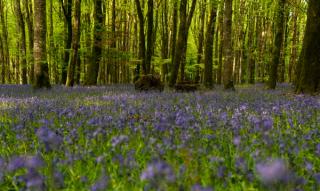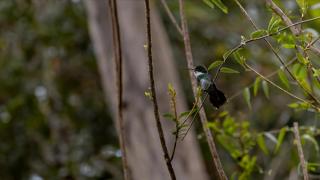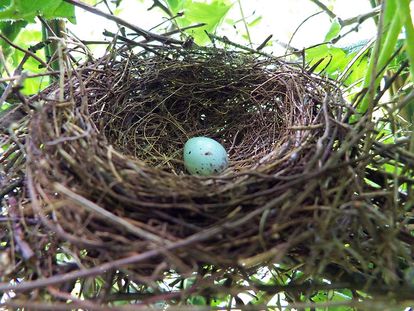
The pitfalls of bird nest searches: A call for smarter bird management
- Post Date
- 20 February 2024
- Read Time
- 7 minutes

As spring and summer arrive, companies often find themselves in a rush to secure wildlife biologists for migratory bird nest searches to minimize disturbing nesting birds around their development sites. What many people may not realize is that by the time the migratory bird season arrives, it may already be too late to reduce risk. Relying on last minute nest searches as a primary mitigation strategy poses a significant risk of project delays, unforeseen costs, and nest disturbances.
Read on to see why reliance of nest searches is risky and what you can do instead to protect your time and budget.

What is a Migratory Bird Nest Search?
The practice of nest searches has become a standard approach to mitigating the risk of disturbing nesting birds during development activities. Prior to vegetation clearing, soil disturbance, construction and other situations, companies enlist the help of wildlife biologists to search project footprints and the surrounding areas for nests. These biologists may actively explore vegetation or passively observe bird behaviour to locate nests. Once a nest is found, wildlife biologists identify the bird species, establish a setback to protect the nest, and monitor the site until the young birds have naturally fledged and left the nest.
Why are Migratory Bird Nest Searches Completed?
Migratory birds and their nests are protected by the federal Migratory Birds Convention Act and Migratory Birds Regulations, as well as various provincial and territorial wildlife legislation. During the spring and summer, birds migrate from the south to the north to nest and raise their young. Conducting development activities, including vegetation clearing, during this time carries the highest risk of disturbing or damaging nests, leading to potential violations of legislation.
Often the first preventative measure to protect birds and remain compliant with legislation is to avoid disruptive activities during the breeding season. However, in cases where scheduling constraints make this impossible, companies sometimes turn to nest searches as a mitigation strategy.
When are Migratory Bird Nest Searches Completed?
In Canada, the migratory bird breeding season varies, and the timing depends on latitude, habitat, and local conditions. Generally, it occurs between late-March and late-August, but it is important to acknowledge that nesting may occur beyond these time frames.
When proponents cannot schedule their activities outside of the migratory bird breeding season, they retain wildlife biologists to complete a migratory bird nest search.

The Concern with Migratory Bird Nest Searches
For starters, bird nests are incredibly difficult to find, and for good reason: there is a host of predators searching for a quick meal. As such, bird nests are well concealed in dense vegetation, camouflaged to look like surroundings, or tucked away in the cavities of trees or high up, and out of sight in the canopy. Searching can take a long time, especially in dense, complex vegetation where there are many places for birds to nest. In fact, if you’ve ever heard a dawn chorus in a local park, the number of birds looking to nest can be staggering! It can also be a challenge to find nests for birds that are incredibly small: such as the ruby-throated hummingbird whose nest is the size of a walnut! The difficulty is compounded when nesting birds try to lure searchers away using distraction techniques such as the famous ‘broken-wing’ display of plovers such as that of the killdeer, or the swooping and dive bombing from birds like terns and the threatened lesser yellowlegs.
Not only are nests difficult to find, but even expert searchers are at a high risk of disturbing the nests. Scaring (also called flushing) adults off the nest could lead to parents abandoning the eggs or increase the chance that predators destroy the nest. As such, searchers themselves may violate the very legislation they may be trying to mitigate for. In addition, a nest search is unlikely to find all the nests in an area and so the risk of disturbing or destroying nests during development activities cannot be eliminated. For these reasons, Environment and Climate Change Canada (ECCC) and the Province of Saskatchewan advise against active nest searches.
In fact, ECCC advises that active nest searches are only appropriate under certain circumstances:
Expertise and Methodology: Active nest searches should be carried out by skilled and experienced observers using appropriate and non-invasive methods. This usually means qualified wildlife technicians and wildlife biologists.
Small Areas and Bird Communities: These searches are most appropriate when dealing with relatively small areas and bird communities, where only a few nesting spots are expected.
Simple Habitat and Low Complexity: The habitat being searched should be straightforward with low complexity. Examples include urban parks, lawns, vacant lots, areas that have been previously cleared, or locations with structures like bridges and buildings.
Nest Visibility: Active searches are best suited for situations where the nests can be easily spotted from a distance, such as in the case of large stick nests or colonial-nesting birds.
To our knowledge, the use of migratory bird nest searches as a mitigation has not been fully tested by the courts. Therefore, projects, especially those without substantial regulatory review and approval, should adhere to ECCC’s recommendations for mitigating risk to migratory birds and complete nest searches only when appropriate and there is a reasonable chance of success.
Where nest searches are not appropriate, ECCC recommends that point counts be completed to indicate the presence of nesting songbirds. This approach is when biologists listen for singing males that indicate territories have been established and nesting has begun. However, this approach will undoubtedly lead to the observation and detection of singing birds as the breeding season progresses. As such, in situations where nest searches are not recommended, it is advisable to avoid the breeding season.
Finally, it’s important to note that while a nest search may be used as a means to navigate vegetation clearance and construction during the breeding season, it's more of a process than a direct form of mitigation. The purpose of nest searches is to locate and protect nests, with mitigation efforts typically involving the establishment of prohibited-entry setbacks and buffers.
These setbacks are maintained until the eggs have hatched and young can fly (i.e., fledged), and have naturally left the nest. This can leave a project stalled for a substantial amount of time, up to several weeks if eggs were recently laid. In other words, finding a nest as crews and equipment are ready to begin can lead to substantial delays, increased costs, and a loss of control over the project schedule.

Planning Ahead
The best approach to dealing with migratory birds, especially for large and complex sites, is to plan ahead. Schedule your activities outside the breeding season, or at the very least, initiate work before migratory birds arrive. By doing so, you can make the project footprint less appealing for nesting. This approach provides you with the greatest certainty that nesting birds are unlikely to affect project construction.
While SLR can provide nest search services when appropriate, we recommend having our wildlife experts create customized mitigation solutions that are tailored to your specific project and timeline. Involve us in the design phase, and we will:
- Assess project footprints for risks associated with migratory birds and other wildlife.
- Plan activities and provide schedules that reduce risk to migratory birds and to project.
- Provide custom mitigation measures for those who must work within the breeding season.
- Help projects maintain compliance with federal and provincial legislation protecting birds and other wildlife.
- Create avian management plans to support project applications, protect migratory birds, and guide construction, operation, and closure activities.
Review the Government of Alberta’s migratory bird guidelines:
Interested in a custom mitigation plan? Get in touch with Stephen at ssymes@slrconsulting.com.
Recent posts
-

-

-

Understanding sound flanking: Fire alarm speaker cable conduits in multi-family buildings
by Neil Vyas
View post